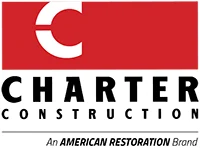Fire damage can be devastating, leaving behind a trail of destruction that demands immediate attention. Fire damage restoration is crucial to reclaiming your space and getting back to normalcy.
This guide helps homeowners and business owners effectively restore their properties after fire damage, ensuring a safe and thorough cleanup process.
Immediate Steps After a Fire
After a fire, there are a few crucial steps you need to take to ensure safety and start restoration:
- Call emergency services to address any immediate threats.
- Get in touch with your insurance company.
- Contact fire damage restoration professionals, like Charter Construction.
- Secure your property to prevent theft or additional damage.
- Assess and document the damage thoroughly by taking photographs and making detailed notes to facilitate your insurance claims process.
Swift action can significantly speed up your timeline and lead to the successful restoration of your property.
Assessing Fire Damage
Assessing the damage involves identifying the extent of fire, smoke, and water damage. After a loss has been cleared by the Fire Marshall, a professional inspection is essential to uncover hidden problems that might compromise your property’s safety and stability. Professional inspectors possess the necessary tools and expertise to thoroughly evaluate the damage and will provide a detailed report that can guide your restoration process.
Types of Fire & Smoke Damage
Fire and smoke damage can manifest in various forms.
- Fire damage may include charred materials, melted items, and compromised structural components.
- Smoke damage often results in sticky soot residues that adhere to surfaces and pervasive odors that infiltrate fabrics, walls, and ventilation systems.
The intensity of the fire and the materials burned can also produce different types of smoke, such as wet smoke from smoldering fires or dry smoke from fast-burning fires.
Each type of damage requires specific cleaning methods and restoration techniques to ensure thorough remediation.
What is Fire Damage Restoration?
Fire damage restoration involves addressing various types of damage, including structural issues, smoke damage, and water damage resulting from firefighting efforts. Choose a restoration company with certifications, experience, and positive customer reviews. A reputable company will provide a clear plan of action, estimated timelines, and a detailed cost breakdown. They will manage all aspects of the restoration process, ensuring thorough communication and professional handling. Their expertise ensures your property is restored to a safe and habitable condition.
Fire Damage Cleanup
The fire damage cleanup phase requires the removal of soot, smoke residues, and hazardous materials left behind. Deep cleaning of surfaces and airing out affected areas are necessary steps to eliminate odors and toxins effectively.
Addressing water damage from firefighting efforts is crucial, as lingering moisture can lead to mold growth and further complications.
Professional cleanup services employ specialized equipment and techniques to ensure that all contaminants are thoroughly removed, minimizing health risks and preventing additional damage to the property.
Repair and Rebuilding After a Fire
Restoring a damaged property involves addressing structural issues and replacing materials that cannot be salvaged. It may also necessitate rebuilding compromised areas or sections of the home or building that were entirely lost.
Choosing between professional restoration services and DIY approaches depends on the project’s complexity, budget, and your expertise. Professionals can provide warranties and guarantees, ensuring quality work and peace of mind.
Preventing Future Fire Damage
To improve your property’s fire safety, consider these tips to prevent future damage in the event of a fire:
- Start by installing fire-resistant roofing, siding, and insulation. These materials can significantly reduce the risk of fire spreading and provide added protection.
- Regularly inspect and maintain electrical systems, heating equipment, and appliances to identify and fix potential fire hazards.
- Keep flammable materials, such as gasoline and cleaning supplies, stored in safe, designated areas away from heat sources.
- Equip your property with smoke alarms and fire extinguishers, ensuring they are in working order and easily accessible.
- Regularly test smoke alarms and replace batteries as needed.
- Manage landscaping by clearing out debris and dead vegetation.
- Educate all occupants about fire safety practices and conduct fire drills to ensure everyone knows the emergency escape routes and procedures.
Keeping your property free from clutter and ensuring clear access to exits can also enhance safety and facilitate a quicker evacuation if needed.
A comprehensive approach to fire damage restoration involves taking timely action, conducting a professional assessment, and implementing effective cleanup. By addressing each step methodically, you can ensure that your property is restored to a safe and habitable condition.
Preventive measures are equally important in safeguarding your home or business from future fire risks. With proper planning and maintenance, you can significantly reduce the likelihood of fire-related incidents. Whether you choose to work with professional restoration services or tackle some tasks on your own, the key is to act promptly and follow best practices.
For more information, read our Dos and Don’ts of Fire Damage Claims.
Have questions? Contact our Team at 208-488-5224 in Idaho, 206-382-1900 in Seattle or 503-546-2600 in Portland.

